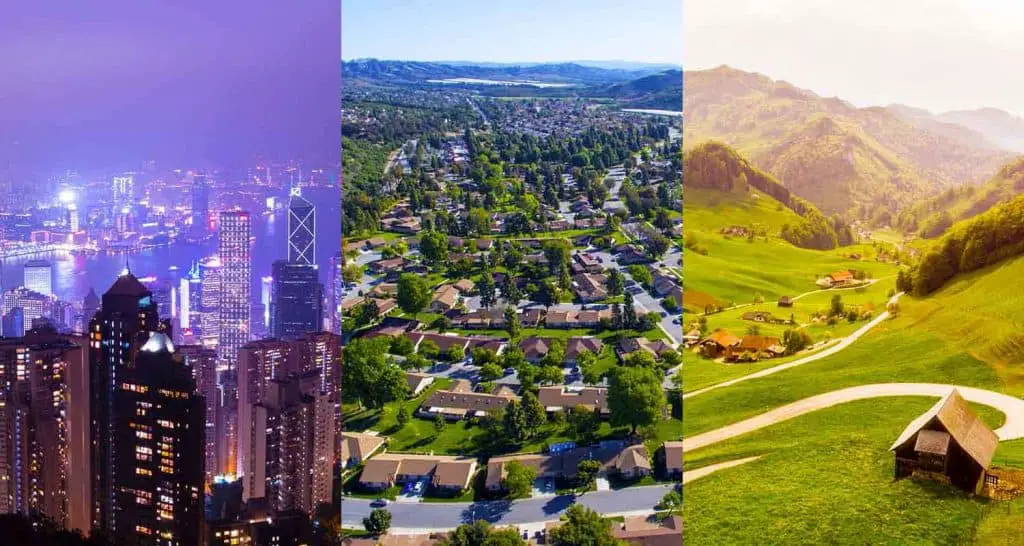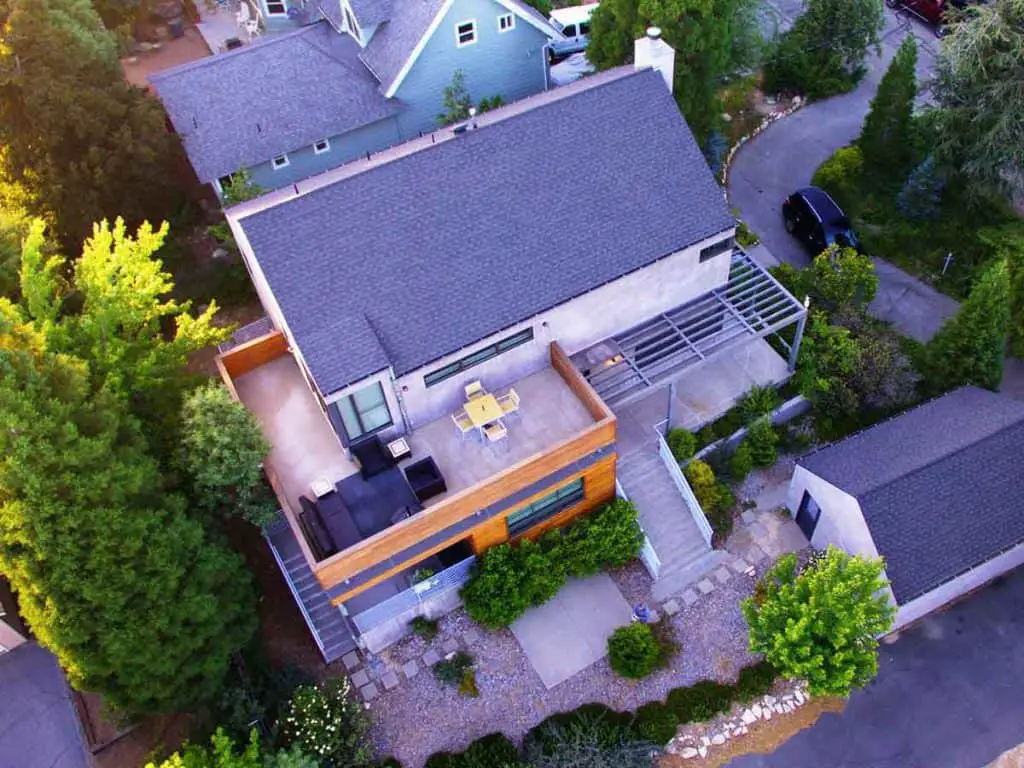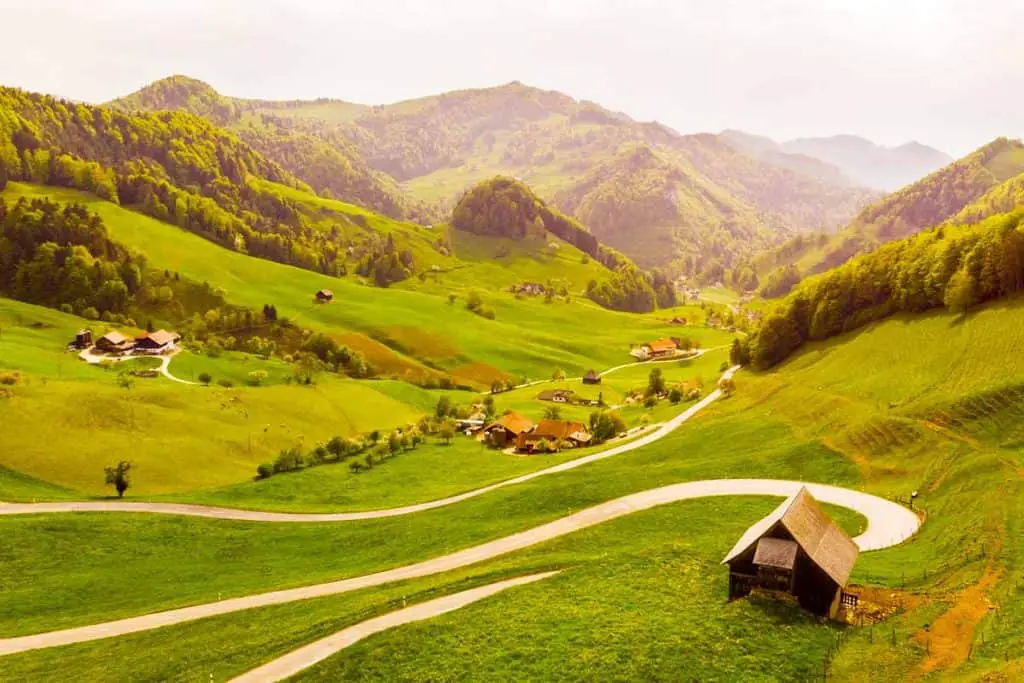Urban vs. Suburban vs. Rural (Everything you need to know!)
If you ask someone to describe where they live, one description includes urban vs. suburban vs. rural.
Everyone knows what an urban location is rather than a rural one, but what does it really mean?

Urban vs. Suburban vs. Rural
You know urban involves human-made structures, with a high population density, and rural means open fields and not many people. Suburban is that place between the city and the countryside where most people raise their families.
Is there a more precise, more scientific definition than that?
Interestingly, there isn’t a universal worldwide definition you can apply to categorize one area as urban and another as rural.
One of the best indicators in the US is asking people to define their living space. On this basis, 52% of Americans live in the suburbs (source).
Population Density
The population density is the critical factor, but it varies between countries. For example, as a densely crowded island, Japan defines urban areas as settlements containing more than 30,000 people.
In the US, the bar for classing as urban is lower as places with 2,500 people meet the criteria.
In the US, a zip code definition of the difference between urban, suburban, and rural relies on population density:
- Urban is when you live within 12 miles of a city center, and your area accommodates 1,314 or more households per square mile.
- Suburban is when you live within 12 miles of a city center, but the population density is less than 1,314 households per square mile. Plus, you can also be in the suburbs more than 12 miles from the city center, provided the population density is more than 106 households per square mile.
- Rural is any location with a population density of fewer than 102 households per square mile.
(source)
Development Planning and Architecture
Urban environments depend heavily on architecture – homes, offices, business premises, civic buildings, leisure buildings with some carefully planned and cultivated green spaces for play, exercise, and improved mental health.
Suburban areas involve family homes, schools, and some amenities, but suburban areas are about giving people somewhere to sleep and raise their families.
The expectation is that you leave the suburbs to shop or work. Increasingly suburban areas are places where people rely heavily on their car for the shortest trip to visit a doctor, gym, or enjoy a walk.
Rural areas vary from cultivated farms and agriculture to wilderness habitats.
Civilized rural areas are about growing food and servicing rural industries. The wilder areas are for outdoor fun and space for the natural world to coexist with humanity.
Most US states try to confine their urban sprawl to maintain rural areas as separate from the urbanized areas. Development planning is a tool that can achieve these aims by restricting house building to defined zones.
Urban areas contain architecture defining culture and aspiration because that is where the highest population density needing access to buildings lives. Rural facilities are often functional and somewhat temporary.
Housing
The difference between urban, suburban, and rural housing involves the associated land. You get a lot of land with your house in rural areas, and your nearest neighbor is some distance away.
Suburban housing mimics rural housing in giving you a house with some land, but the ground is limited to a garden space. You can get condo complexes and gated communities inside suburban areas that give you shared access to land.
Space in urban areas is at a premium – apartment blocks, condos, townhouses, and few gardens are typical accommodation types. You may live above the shop in a fully urbanized area and close to office blocks and shopping malls.
It is rare to find a large single-family home in an urban setting; most of these historic properties subdivide into smaller units suitable for single occupation or young couples.
Lifestyle Factors
Most people find the idea of living in a rural area attractive – they have a romantic view of enjoying the wonders of nature on their doorstep.
In practice, few people live in rural areas because of the lack of work and social amenities.
Rural areas involve working in agriculture – traditionally a low-paid profession or being a wealthy retiree.
Living in a rural rea means driving some distance to pick up groceries, buy clothes, or enjoy a night out in a restaurant or movie theater. It is also more difficult to access education and health care.
Urban living means access to many resources on your doorstep or via convenient public transport. Urban living gives you museums, art galleries, shops, leisure centers, theaters, coffee shops, and restaurants.
Plus, urban areas have plenty of work available, from low-skilled to professional.
Suburban areas are a buffer zone between the countryside and the city.
People choose to live in the suburbs because you get more room than in the urban areas and separation from your workplace. Plus, you get that sense of family and community with access to schools and health care.
People find it more convenient and affordable to live in suburban areas and work in urban areas.
Communities
People make communities.
In rural areas, community activity relies on geography, but in urban areas, more people mean opportunities for more communities of interest.
The more densely populated suburban and urban areas have affordable meeting rooms and easy transport links facilitating reading groups, evening classes, and social groups to pursue a hobby like wine tasting or model railways.
Rural communities have fewer opportunities for the same variety of social interactions.
The world is becoming more urban as young people head towards the cities searching for jobs and friends. Living in rural areas is more time-consuming and restrictive in terms of employment and access to amenities like swimming pools, libraries, healthcare, and education.
The most common distinguishing feature in assessing urban vs. suburban vs. rural is the degree of social interaction.
Schools, Colleges, and Universities
You find schools in rural, suburban, and urban areas, but the best schools tend to be suburban.
The suburbs have the desirable combination of plenty of families with school-age children to make running a successful school a viable proposition.
Rural schools suffer from a lack of numbers and resources, and urban schools tend to suffer from poverty and a high crime rate.
There are exceptions in every area where you get a high-performing inner-city school or thriving rural school, but suburban schools are the best in general.
Colleges and universities attract attendees from far away – many need local accommodation. The need for plentiful accommodation and access to amenities results in most colleges and universities’ position in urban centers.
A university can increase the attractiveness of a city or town because more businesses cater to the student population, increasing choice and variety for everyone.
There are rural colleges and universities, but they form campuses with education buildings, living accommodation, and leisure activities. Effectively these densely populated campuses create a small urban area during term time.

Summary of Differences Between Rural vs. Urban Areas
The top differences between urban and rural areas are:
- Distance between homes – urban dwellers live close together, and rural folk live miles apart.
- Public transport – Public transport is plentiful and affordable in urban areas and scarce and expensive in rural ones.
- Private green space – Most city dwellers have limited growing room (may have access to a community garden), but most country folk can have a reasonable garden or wild space.
- Public services – in rural areas accessing a library, doctor, school, police station, or other public services- involve driving to the nearest urban center.
- Leisure activities – swimming pools, bowling alleys, movie theaters, and coffee shops all rely on a high volume of potential customers. Most fun activities are available in urban centers rather than rural ones.
- Work opportunities – the rural economy depends on agriculture and tourism, whereas the urban economy has various jobs at all levels.
- Travel accommodation – Accommodation for businesses and travelers is more available and affordable in urban centers.
- Access to food and clothing – most retail outlets are in urban areas; although food is grown in rural areas, accessing it involves driving to the nearest shopping center.
- Housing costs – – buying an apartment or condo in urban locations tend to be more expensive than buying one in rural areas. There are exceptions for rural areas adjacent to large urban areas where the prospect of having an attractive garden and house can push up the prices.
- Crime – rural crime and urban crime is different in frequency and nature. There are fewer opportunities for muggings and assault in rural areas because of the lower population density. But in a rural area, there is less chance of a bystander calling for assistance, and it takes a long time for someone to come to your aid.

Benefits of City Living
Cities attract young and old because city living has the advantages of:
1. Public Transport
As an adult who can drive, access to a reliable and affordable public transport network may not seem that big a deal.
But for the elderly who can no longer drive, young people without a license, and people who prefer not to own a car, city living with its transport networks improves their quality of life.
Commuting by public transport gives you reading and thinking time, lets you enjoy wine with your meal and helps drive an active social life for young and old.
Contrast life in the country where children can only visit their friends by arrangement with a parent willing to drive them and pick them up.
2. Independent Housing
Cities offer a range of accommodation suitable for people on their own, families and shared accommodation. Rural housing tends to be scarce and difficult to acquire.
Young adults looking to live independently are more likely to find work and accommodation in an urban environment.
3. Food Culture
Cities with their larger populations can support restaurants, cafés, bars, and takeaways. You can eat out or have a takeaway with a range of cuisine on offer from vegan to Michelin starred chefs.
Besides the opportunities to eat prepared meals drawing on worldwide flavors, you get access to global foodstuffs.
Most cities have an ethnically diverse population, which drives demand and availability for food ingredients you can’t easily access in rural areas.
4. Retail Therapy
If you love shopping, then cities allow you to browse, try on clothes, and buy more than most rural communities.
Again, a larger population means independent and quirky shops can find customers that keep them open and thriving.
Although online shopping has increased the availability of goods to buy, there is still the pleasure of finding a bargain or something you did not realize you wanted until you saw it in a shop window.
5. Access to the Arts
Art galleries, museums, and live theater are more accessible to city dwellers than rural ones. If you love to attend new exhibitions and activities, you are more likely to get regular access to the latest exhibits as a city dweller.
You can walk around a city and absorb history and culture from the buildings, street art, and street entertainment. Cities are places for people to gather, and human activity dominates the landscape.
6. Access to Learning
As a city dweller, you get ready access to various learning opportunities from music, craft, or learning a language. You get options for formal learning with examinations or informal learning with a group.
Most of these opportunities will be on your doorstep or a short hop on public transport.
7. Entertainment and Leisure
City living gives you plenty of opportunities to enjoy your free time. Businesses provide opportunities for fun and exercise, from bowling alleys to climbing walls.
You can access dance and exercise classes, parks, and any other social activity that people are interested in, from book clubs to amateur dramatics.
8. Public Services
You get access to more public services in city locations, from road cleaning to rapid access to the fire or health service. It makes sense to provide public services in the greatest population density areas as it is more economically viable.
For an aging population, this means ready access to health and social care at an affordable price and with plenty of choices.
9. Social and Community Interaction
City living gives you more opportunities to meet people and volunteer for community groups. There is more activity in cities, so more people can meet and get involved.
Rural areas have community volunteering and meet-ups, but it is with a smaller population and fewer opportunities to get involved.

Benefits of Country Living
Many people aspire to country living, often because of an idealized view of what it means to live in the country, but there are some significant benefits to country living.
1. Room to Breathe
Country living gives you space. Most rural properties have plenty of land associated with the house.
This access to land means you can grow flowers, fruit, and vegetables. Plus, you can keep livestock on a farming scale or as a hobby.
Gardening on a professional or amateur scale is one of the best activities for physical and mental health. Growing space inside a city is scarce and difficult to access, but most country dwellers have plenty of land for outdoor gardens.
2. Clean Air
Country air is not entirely free of pollution – widespread environmental pollutants affect country people as well as city dwellers.
Country air generally has fewer pollutants than city air because there are no buildings to trap it close to ground level. Plus, there is less traffic and industry and more trees and bushes.
3. Closer to Nature
You can see wildlife making a home in the city; many urban naturalists delight in finding nature joining the human desire for urbanization.
Most wildlife remains in the countryside. If you enjoy interacting with birds, animals, and insects, the countryside has more variety and quantity than city streets.
4. Dance to a Slower Rhythm
City life is fast-paced with people rushing to work, running around the block with headphones on, tearing around the shops, trying to beat the rush to the restaurant, and generally more pressured to be busy.
Country life is more measured – partly because you need to plan to go shopping, visit the bank or take the kids to school because of the distances involved.
There are pressures to country life – harvest time or natural disasters, but country life has its own rhythm, and country folk march to a slower beat.
5. Less Crime and Grime
You get rural crime, fly-tipping, and litter in the countryside, but it is different from city life. The distance between people in the country makes the daily city crimes of bag snatching, selling drugs, and burglary less possible.
Most crimes that bother people are committed by other people – lower the population density, and you change the crime rate and type.
6. Deeper Relationships
In rural areas, you have fewer neighbors and fewer opportunities to meet new people. Successful country life means getting to know your neighbors and building strong relationships with the people you know.
Country people need to rely on people to help them out – moving livestock, closing gates, sharing shopping – when you lie in a remote location, you may be self-reliant, but you still need people.
7. Beautiful Views
Most people prefer to see a natural landscape than a city view.
It is more restful on the eyes, and it lowers your blood pressure. Access to green spaces is better for your mental health than a constant environment of stone and glass.
City dwellers get their green fix from parks and holidays, but country dwellers live in green spaces with a natural soundscape to gladden their hearts and calm their minds.
8. Peace and Quiet
The countryside is not silent, but it is a different quality of noise to that of your neighbor’s TV or music at 4.00 am, the roar of traffic, the screech of sirens, and the constant hum of too many people in a small space.
By comparison to cities, country life is quiet and peaceful. The noises are different but relaxing, and generally, you do not have noisy neighbors of the human variety.
9. Privacy
An absence of near neighbors gives you the privacy that is lacking in a city.
There is no one to observe your comings and goings. You have the privacy to be yourself and live the life you want without being watched and judged by others.
If you want to practice your piano at 2.00 am there is no one to complain about the noise, and you can mow your lawn in your pajamas if you wish. Plus, at least you have a lawn to mow.
Why is the World Becoming More Urban?
Given the romantic view so many people hold about the joy of country living, why is the world becoming more urbanized?
Social trends indicate two-thirds of the world population will live in urban areas by 2050.
Urbanization is important and better for most people because it is an efficient way of living with many benefits for individuals and society:
- Better economy – more people equal more business to take advantage of the market and labor force.
- City dwellers are wealthier – more available work and lower costs of transport, food, and entertainment. It is cheaper to live in a city than in the country for many young people.
- Public services – it is more efficient to offer public services in an urban setting. The people are close to the services they need, and it costs less to deliver.
- More opportunities – cities have everything a person wants from libraries, shopping, and plenty of people to mix with at work and play.
- Resource-efficient – it is easier and more economical to power a city and provide utilities like Wi-Fi in urban areas than rural ones.
- Better land use – housing a growing population in apartment blocks is more efficient than concreting over prime agricultural land. Denser city populations can reduce human impact on nature.
- Lower carbon footprint – you can drop the car with excellent, affordable public transport.
Despite the advantages, there are some downsides to urbanization, especially poorly planned urban centers:
- Water drainage – hard surfaces drain the water away (potentially causing flooding) rather than capturing it for use. Some urban development is looking at better water management through absorption of rainfall and floods through better design.
- Pollution and environmental impact – waste products need processing in bulk, and human activity (with pollution impact) concentrates in a small, densely populated space. Some innovative urban planners are looking at using waste to generate power for cities in a virtuous cycle.
- Food miles – urban areas, by definition, do not grow food, and all food has to travel into the city. Again, this is an area where urban dwellers are looking at green walls and other ways of ensuring that urban areas grow food locally.
- Crime and violence – dense populations increase the crime rate. Urban planners and law enforcement are all looking at ways to make urban settings safer for everyone.
- Poverty – poverty and deprivation continue to be a feature of most cities, confined to specific neighborhoods. This is an ongoing problem. But a visible problem gains more assistance from public funds to improve health and economic opportunities for this section of the community.
- Health issues – most diseases spread rapidly by person-to-person contact, and crowded cities are ideal for viruses and other diseases with plenty of hosts. On the other hand, it is quicker and more efficient to deliver health care and preventative measures to an urban population to stop a disease from becoming a significant issue.
The Future is Urban
The drive to more people living in urban settings is part of the human approach. Humans are social animals, and it makes sense to share our resources and live in urban homes for the majority.
Plus, ultimately getting the urban landscape balanced with the natural world through minimizing environmental impact, integrating renewable energy, food production, and water management will be better for the planet.
Cities are wonderful places with all the advantages of modern living for young and old.
Living and working in urban areas preserves the natural environment to retain its capacity to grow food, medicine, and delight the senses with its wonderous interconnected web of plants, animals, and habitats.
Greening our urban areas invites the wild back into our lives while still giving humanity the space it needs to thrive and develop.
Urbanization may be the future, but it is not a bleak dystopian landscape with miserable people eking about existence in a concrete wilderness.
Tomorrow’s urban landscapes are a step towards moving back in harmony with our love of green spaces and desire to connect with nature, changing our cityscapes into a more desirable habitat that rests lightly on the land.
